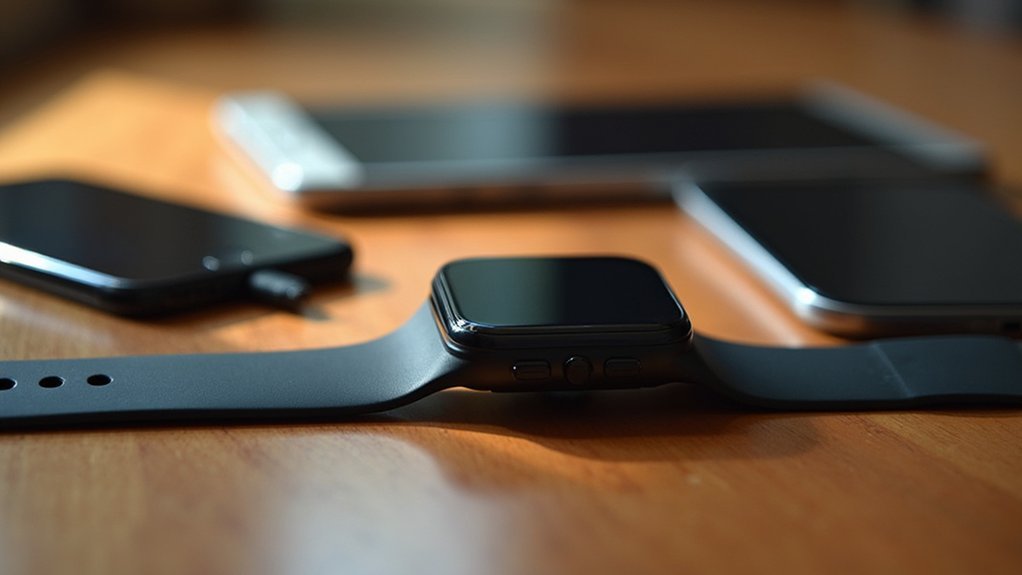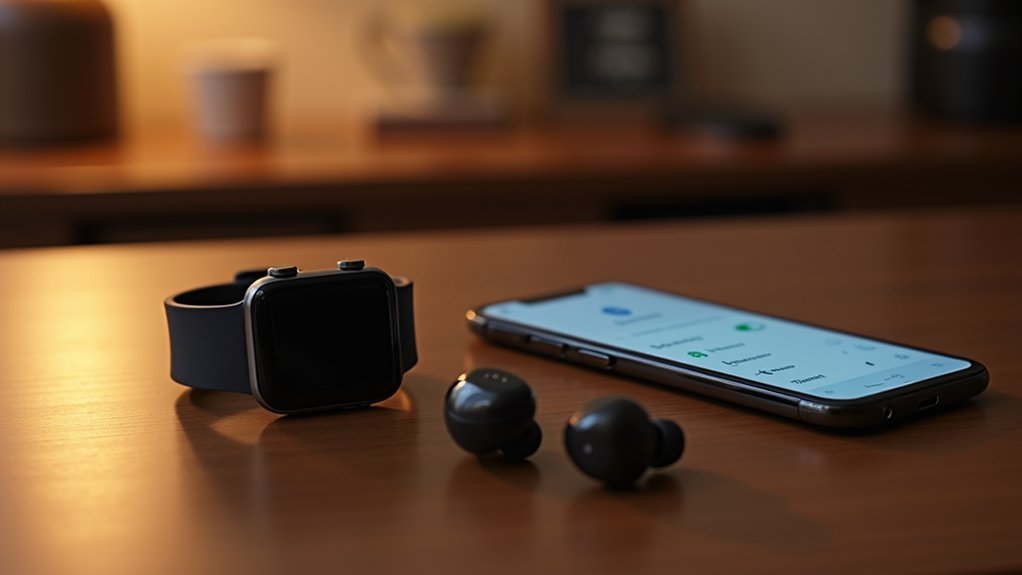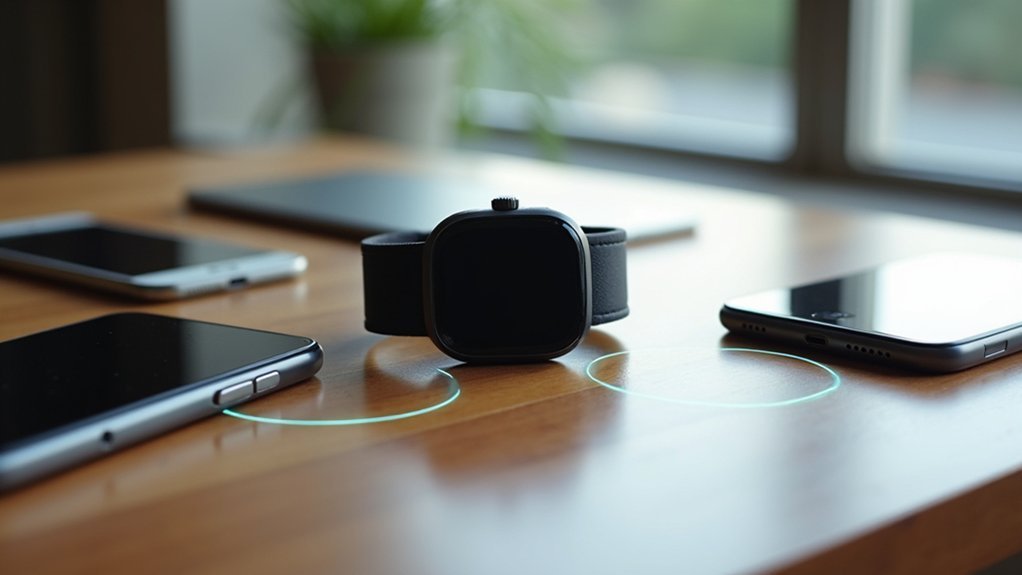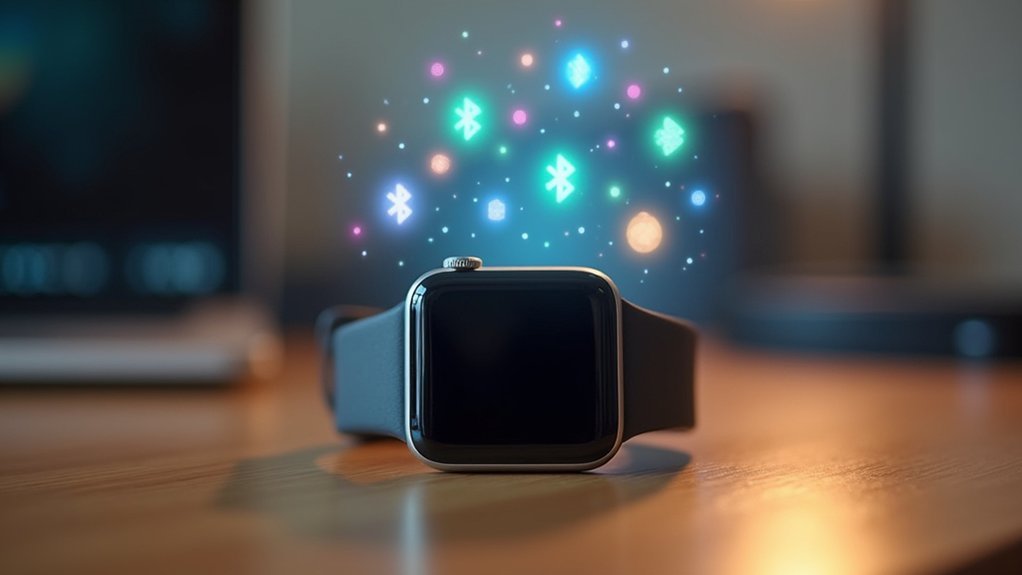You’ll need to verify your smartphone’s compatibility with your smartwatch before purchasing—Apple Watch requires iPhone while most Wear OS 3+ devices only support Android. Charge both devices to 50% before pairing, then enable Bluetooth and launch the companion app. Clear cache and restart both devices if pairing fails, maintaining close proximity without interference. Enable secure pairing with encryption protocols and update firmware regularly for stability. These foundational steps reveal advanced optimization strategies for seamless connectivity.
Verify Cross-Platform Compatibility Before Purchase

Why settle for a smartwatch that won’t work seamlessly with your smartphone? Before purchasing, you’ll want to verify compatibility between your phone’s operating system and your chosen smartwatch.
Apple Watch exclusively requires iPhone for setup and full functionality, while most Wear OS 3+ devices like Samsung Galaxy Watch only support Android phones. However, Fossil Gen 6 remains one of few Wear OS devices supporting both platforms.
For broader compatibility, consider Garmin, Amazfit, or Withings watches that work with both Android and iPhone. The TicWatch Pro 3 Ultra supports WearOS and maintains compatibility with both iOS and Android devices. Fitbit trackers also provide cross-platform support, though some advanced features may be restricted on iPhones.
Remember that even compatible devices might’ve limited app access, delayed software updates, or restricted features compared to native ecosystem alternatives.
Master the Initial Bluetooth Connection Process
Five essential steps will transform your smartwatch from an expensive paperweight into a fully functional wearable companion.
First, charge both devices to at least 50% battery to prevent interruptions during pairing and firmware updates.
Next, enable Bluetooth in your phone’s settings before launching the official companion app like Wear OS or Galaxy Wearable. Grant all requested permissions for contacts, notifications, and location access to enable full functionality.
Download the manufacturer’s official app and select “Set Up” to begin the pairing process. When prompted, confirm matching pairing codes displayed on both devices—restart if they don’t match.
Finally, complete all on-screen instructions while keeping devices close together until your watch shows “Connected” status. Once connected, your smartwatch becomes a personal fitness companion that tracks your health metrics and activity throughout the day.
Resolve Common Pairing Failures Quickly

Three common culprits typically sabotage your smartwatch pairing attempts: corrupted cache data, conflicting Bluetooth profiles, and interference from nearby devices.
First, clear your cache on both devices, then restart them completely. This eliminates stale data that blocks new connections.
Next, forget all existing Bluetooth pairings before attempting fresh connections. Your phone’s Bluetooth settings likely contain corrupted profiles that interfere with new pairing attempts.
Check that you’re within ten meters of each other without walls blocking the signal. Temporarily disable Wi-Fi and disconnect other Bluetooth devices to reduce interference. Ensure your smartwatch is set to discoverable mode for successful pairing.
If problems persist, reset your network settings entirely. Finally, verify both devices run compatible Bluetooth versions and current firmware.
Sometimes pairing with an older phone first, then switching to your primary device, resolves stubborn compatibility issues.
Maintain Stable Connections Throughout Daily Use
Once your smartwatch pairs successfully, maintaining that connection throughout your daily routine requires proactive management of power consumption and signal interference.
Your device automatically uses adaptive frequency hopping to avoid congested channels, but you can optimize performance further.
While your smartwatch intelligently navigates wireless interference automatically, implementing additional optimization techniques will enhance overall connectivity performance.
Key strategies for stable connections:
- Enable context-aware data transmission – Your smartwatch should adjust transfer frequency based on screen status and usage patterns to conserve battery while maintaining connectivity.
- Utilize two-stage sensor processing – Filter data locally before transmission to minimize unnecessary Bluetooth activity and reduce power drain.
- Monitor environmental factors – Be aware that obstacles and crowded wireless environments can affect range, though Bluetooth can exceed 1 kilometer in ideal conditions.
Regular firmware updates patch security vulnerabilities that could destabilize your connection. These updates become increasingly important as smartwatches integrate with the broader Internet of Things ecosystem, where device interconnectivity creates additional security considerations.
Maximize Bluetooth Feature Integration Across Devices

When you’ve established a stable connection between your smartwatch and smartphone, the next step involves leveraging cross-device integration to access your wearable’s full potential. You’ll want to optimize Bluetooth settings for low latency data transfer and activate Bluetooth Low Energy (BLE) to conserve battery life while maintaining connectivity.
| Feature Category | Enhancement | Benefit |
|---|---|---|
| Audio Quality | Enable aptX/AAC codecs | Superior music streaming |
| Data Transfer | Optimize speed settings | Faster sync across devices |
| Energy Management | Use BLE protocols | Extended battery life |
| Compatibility | Support wide device range | Seamless platform integration |
Focus on configuring advanced audio features for better streaming quality and verify your devices support the latest Bluetooth versions for improved range and performance across different platforms. Android Studio automatically remembers paired devices and re-establishes connections when you launch the development environment again.
Implement Security Measures for Safe Pairing
While optimizing your smartwatch’s Bluetooth performance enhances functionality, protecting your device from security threats requires equal attention.
Bluetooth Low Energy vulnerabilities can expose your data to attackers through eavesdropping and man-in-the-middle attacks. You’ll need robust security measures to safeguard your personal information.
Implement these essential security practices:
- Use secure pairing methods with six-digit random PINs and encryption protocols to prevent unauthorized access
- Enable authentication mechanisms like two-factor authentication and configure your watch to remain undiscoverable until pairing
- Install regular security updates and turn off Bluetooth when not needed to reduce attack surface
You should only accept pairing requests from trusted devices and set up Activation Lock to prevent stolen smartwatches from being accessed by unauthorized users. Choose smartwatches from trusted brands that implement stronger security measures compared to low-end models that often lack essential protection features.
Optimize Performance Across Different Smartwatch Operating Systems
You’ll discover that each smartwatch operating system requires different optimization settings to maximize Bluetooth performance and battery efficiency.
Wear OS, watchOS, and Tizen OS each handle cross-platform connectivity differently, affecting how smoothly your device pairs and syncs with various smartphones.
Regular OS updates can greatly impact your smartwatch’s Bluetooth stability and performance, so you’ll need to adjust your settings accordingly after each update. Apple Watch compatibility is exclusively limited to iPhone users, which can simplify the pairing process but restricts cross-platform flexibility.
Platform-Specific Optimization Settings
Although each smartwatch operating system shares core Bluetooth functionality, enhancing your device’s performance requires platform-specific adjustments that address the unique characteristics of watchOS, Wear OS, Tizen, and other systems.
You’ll need to leverage each platform’s unique tools to maximize Bluetooth efficiency. For Apple Watch users, utilize handoff features and iOS integration settings. Wear OS owners should access Google’s device management tools and Android-specific battery optimization. Samsung Galaxy Watch users can take advantage of Tizen’s power-saving modes and Samsung Health integration.
Consider these platform-specific optimizations:
- Native ecosystem integration – Use built-in platform features for smoother Bluetooth sync
- OS-specific battery management – Enable platform battery saver modes during pairing
- Custom notification filtering – Leverage each OS’s notification management tools
These targeted adjustments guarantee peak Bluetooth performance across different smartwatch platforms. Premium models like the Apple Watch Ultra 2 and Garmin Epix Pro Gen 2 offer advanced connectivity features that require specialized pairing protocols to fully utilize their enhanced capabilities.
Cross-Platform Performance Differences
Understanding how different smartwatch operating systems handle Bluetooth connectivity helps you choose the right optimization strategies for your specific device.
WatchOS delivers the most stable performance due to Apple’s tight hardware-software integration, ensuring minimal dropouts and fast pairing exclusively with iPhones.
Wear OS devices show variable stability depending on manufacturer customization, sometimes experiencing intermittent connection drops across Android and iOS phones.
Samsung’s Tizen provides solid connectivity with Galaxy smartphones but performs less reliably on non-Samsung devices.
Bluetooth version support varies considerably—newer Wear OS and watchOS devices support Bluetooth 5.0+ for improved range, while older Tizen watches may lag behind.
Cross-platform audio connectivity can display inconsistencies due to differing OS-level Bluetooth stack implementations, affecting pairing speed and reconnection reliability. Battery optimization features in each operating system can also impact Bluetooth connectivity by managing power consumption differently across platforms.
OS Update Impact
When smartwatch manufacturers release OS updates, they fundamentally alter your device’s Bluetooth performance and compatibility.
You’ll notice varying impacts depending on your platform choice, with some systems prioritizing stability while others focus on feature expansion.
Different operating systems handle Bluetooth connectivity changes through updates in distinct ways:
- Wear OS and watchOS deliver annual major updates that can introduce new pairing protocols and enhance connection stability.
- Zepp OS and Fitbit OS provide less frequent updates, typically maintaining existing Bluetooth functionality rather than expanding it.
- Custom platforms like Garmin rarely update Bluetooth features but offer exceptional long-term stability.
You should expect prompt security patches on Samsung, Google, and Apple devices, while other platforms may leave you waiting months for critical Bluetooth vulnerability fixes that affect pairing reliability.
Premium devices with titanium casings often receive priority treatment for OS updates, ensuring enhanced durability features remain compatible with the latest Bluetooth standards.
Frequently Asked Questions
Can I Pair One Smartwatch With Multiple Smartphones Simultaneously?
You can’t pair most smartwatches with multiple smartphones simultaneously for full functionality. Some devices allow limited connections, but you’ll typically need to reset your watch to switch between phones completely.
Does Bluetooth Pairing Drain My Smartwatch Battery Faster Than Normal Use?
Bluetooth pairing doesn’t greatly drain your smartwatch battery compared to features like GPS or always-on displays. BLE technology minimizes power consumption, though frequent disconnections and reconnections can increase energy usage slightly.
Will My Smartwatch Work if My Phone’s Bluetooth Is Temporarily Disabled?
Your smartwatch won’t receive notifications, calls, or sync data when your phone’s Bluetooth is disabled. Basic functions like timekeeping work, but most smart features require an active Bluetooth connection to function properly.
Can I Use Third-Party Apps to Improve Bluetooth Connection Between Devices?
You can use third-party Bluetooth apps to enhance connectivity between your smartwatch and phone. They offer improved notification management, customizable features, cross-platform compatibility, and troubleshooting tools that resolve common sync issues.
How Far Can I Go From My Phone Before Losing Connection?
You’ll lose connection around 30-33 feet from your phone in open spaces. Walls, interference, and obstacles reduce this range considerably. Your smartwatch may reconnect via Wi-Fi if available.
In Summary
You’ve got all the tools you need to master Bluetooth pairing across any smartwatch platform. Don’t let compatibility issues hold you back—verify before you buy, troubleshoot problems quickly, and prioritize security throughout the process. Your smartwatch experience depends on solid connections, so implement these strategies consistently. Whether you’re using Apple Watch, Wear OS, or other platforms, you’ll maintain reliable pairing and access your device’s full potential.





Leave a Reply